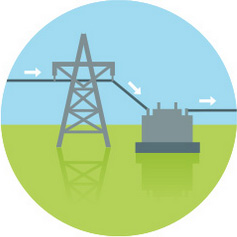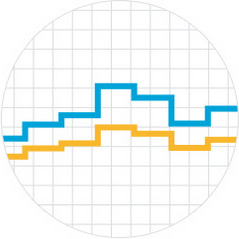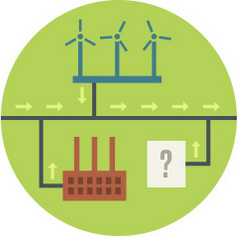
The REO describes the decarbonization journey happening in New England and how the ISO is working to ensure a reliable power system and competitive wholesale electricity markets that will enable the clean-energy future. For updated facts and statistics cited in the REO, view our Key Grid and Markets Stats pages.
With increasing amounts of intermittent energy sources joining New England’s resource mix, the need to balance a more complex electricity grid has emerged.
Watch a trio of videos detailing the work being done behind the scenes at ISO New England to weave wind energy into our operations, markets, and system planning procedures.
Get an overview of the effects that solar photovoltaic (PV) systems have on demand from the regional power system and how the ISO is handling related challenges.
The New England states have set aggressive policy goals to lower carbon emissions and increase the amount of renewable energy, and are national leaders in implementing energy-efficiency (EE) measures, such as the use of more efficient lighting, appliances, cooling, and building operation. Modernizing the electric power grid is also a priority in New England and across the country.

Get the basics on how electricity gets to New England’s homes and businesses.
Each week from December through March, the ISO publishes the 21-Day Energy Assessment Forecast and Report—a rolling, three-week outlook of anticipated power system conditions.
A dependable flow of electricity is priority number one for the ISO. Learn what this means from both a practical and technical perspective.
For the past two decades, ISO New England (ISO) has raised concerns about fuel supply issues limiting electricity supplies during periods of extreme cold weather. This timeline reflects the ISO’s efforts to address regional energy adequacy concerns.
Electricity is measured in both capacity and energy—watts and watt-hours. Understanding the difference is critical to understanding how the power grid works.
Watch short videos that explain how load ramping, voltage, and frequency help maintain power grid reliability—and how they’re affected by the increasing penetration of variable generation. The videos are presented by the North American Electric Reliability Corporation (NERC).
Get an overview of the ISO’s regulatory environment and stakeholders in its role as Regional Transmission Organization (RTO) for New England.
How industry restructuring and ISO innovation have helped transform the regional electricity industry and revitalize New England’s power system
Learn about the intensive work that goes into developing and documenting compliance with standards that help ensure the reliable operation of the power grid.
How the ISO is protecting against cyberthreats to ISO systems that could affect the operation of the power system or wholesale electricity marketplace
The ISO’s varied roles and responsibilities require a broad spectrum of professionals in a highly competitive industry.
Learn how the ISO funds its operation, develops its annual budgets, and determines its yearly service rates for customers.
Key facts and figures on regional demand growth, resource mix, transmission development, and prices.
Key facts and figures on demand growth, resource mix, and environmental goals for each New England state.

Your electricity needs never stop, and neither does the ISO. Download this booklet for a “tour” of our state-of-the-art control room and an overview of how the ISO’s system operators keep electricity supply and demand in near-perfect balance every minute of the day.
In and of themselves, capacity deficiencies are not emergencies. They simply mean that ISO operators are taking additional actions to maintain system reliability.
When conditions allow, the ISO will call for businesses and residents to conserve as a way to avoid or limit the need for controlled power outages.
In extreme situations, after exhausting other options, ISO New England may initiate controlled power outages to prevent a collapse of the power system.
To keep this system reliable, ISO New England maintains a constant balance of supply and demand. But when this balance is at risk for whatever reason—if there is too much consumer demand or too little generating supply—the ISO takes series of steps to avoid a more serious emergency. These steps include importing power from neighboring regions, using power system reserves, and asking consumers to reduce their electricity usage.
How the region’s inadequate natural gas delivery infrastructure affects the ability of natural-gas-fired plants to get the fuel they need to perform, affecting reliable operation of the power system
Why New England is losing large amounts of coal- and oil-fired and nuclear generating capacity, and how this affects operation of the power system
Among the ISO’s responsibilities as Regional Transmission Organization is the scheduling and coordination of transmission equipment outages (periods when equipment is out of service). Learn more about this role, how it helps ensure reliability, and how it saves the region millions of dollars.
Learn how the ISO takes steps to help protect the power grid in the event of predicted geomagnetic disturbances caused by solar events.

Learn how the ISO uses weather forecasts in formulating electric demand estimates.
Learn how ISO New England plans for the region’s energy use on this not-so-typical Thursday morning.
Read about how the ISO creates forecasts of New England’s electricity needs.
Learn how temperature and other factors affect the grid—and the actions the ISO takes when electricity demand is outpacing supply.

Get the basics on how wholesale prices affect retail rates, and how you can spot these in your retail electricity bill.
The goal of energy markets is to provide reliable wholesale electricity at competitive prices. The markets accomplish this goal using two core mechanisms: economic dispatch and uniform clearing price.

The region’s transmission owners develop transmission rates in New England—learn more.